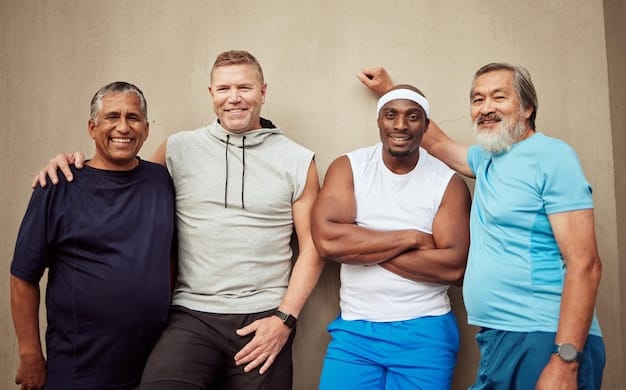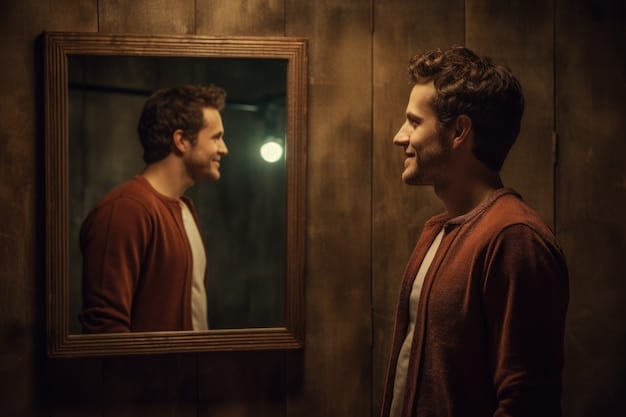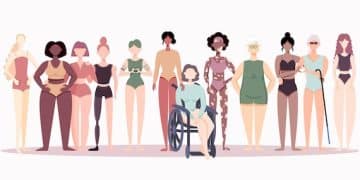Body Positivity for Men: Challenging Societal Norms

Advertisements
Body positivity for men involves challenging societal expectations surrounding male body image and promoting self-acceptance regardless of physical appearance, fostering mental and emotional well-being by encouraging a healthier relationship with their bodies.
Advertisements
Body positivity for men: breaking down societal expectations is a crucial movement that encourages men to embrace their bodies as they are, free from the unrealistic standards often portrayed in media. This article explores how stereotypes affect men’s self-esteem and offers practical steps toward self-acceptance.
Understanding Body Image Pressures on Men
Advertisements
Men face immense pressure regarding their body image, stemming from media portrayals, social expectations, and peer comparisons. These pressures can lead to significant mental health issues and reduced self-esteem. Recognizing the origins and impact of these pressures is the first step towards fostering body positivity.
The Media’s Influence on Male Body Ideals
Media often showcases unrealistic body ideals for men, emphasizing muscular physiques and chiseled features. These images are frequently achieved through rigorous training, strict diets, and sometimes even cosmetic procedures, yet presented as the norm. The disparity between these ideals and reality contributes to negative body image among men.
Social Expectations and Peer Pressure
Social circles and peer groups can inadvertently reinforce harmful body standards. Casual comments, comparisons, and expectations about physical appearance can significantly impact a man’s self-perception. This pressure can be particularly acute during adolescence and young adulthood.

- Unrealistic Standards: Men are often bombarded with images of overly muscular and lean physiques, setting unattainable benchmarks.
- Mental Health Impact: The constant comparison to these images can lead to anxiety, depression, and other mental health challenges.
- Self-Esteem Issues: Feeling inadequate can erode self-esteem and confidence, affecting various aspects of life.
- Body Dysmorphia: In extreme cases, men may develop body dysmorphic disorder, an obsession with perceived flaws in their appearance.
Addressing these pressures requires a conscious effort to challenge media portrayals and redefine social expectations. By promoting diverse representations of male bodies, we can help men develop a healthier relationship with their appearance.
Challenging Toxic Masculinity and Body Image
Toxic masculinity often intertwines with body image pressures, dictating that men must be strong, dominant, and physically imposing. Challenging these norms is essential for fostering a more inclusive and accepting environment where men feel free to embrace their bodies without judgment.
Redefining Strength and Masculinity
Traditional notions of strength often equate it with physical prowess, neglecting other forms of strength such as emotional resilience, intellectual capabilities, and creative expression. Redefining masculinity to encompass these diverse aspects undermines the pressure to conform to a narrow physical ideal.
Promoting Body Diversity
Celebrating the diversity of male bodies is crucial in dismantling unrealistic standards. Recognizing that men come in various shapes, sizes, and physical conditions normalizes different body types and promotes self-acceptance. Increased representation in media and advertising can play a significant role in this shift.

Challenging toxic masculinity involves encouraging open conversations about body image and mental health among men. Creating safe spaces where men can express vulnerability and share their struggles without fear of judgment is vital for fostering a supportive community.
Practical Steps to Challenge Toxic Masculinity
- Open Conversations: Encourage men to discuss their feelings about body image and societal pressures openly.
- Support Groups: Create or join support groups where men can share experiences and strategies for coping with body image issues.
- Media Literacy: Educate men about the unrealistic portrayals in media and how to critically evaluate these images.
By challenging toxic masculinity and promoting body diversity, we can create a more accepting and inclusive environment where men feel empowered to embrace their bodies and prioritize their well-being.
Practical Steps Toward Body Acceptance
Building a positive body image is a journey that requires consistent effort and self-compassion. Implementing practical strategies can help men develop a healthier relationship with their bodies and challenge negative self-perceptions.
Mindful Self-Reflection
Practicing mindful self-reflection involves observing thoughts and feelings about one’s body without judgment. This can help identify negative thought patterns and challenge their validity. Regular journaling or meditation can facilitate this process.
Focusing on Health and Well-being
Shifting the focus from appearance to health and well-being can transform the way men perceive their bodies. Engaging in activities that promote physical and mental health, such as exercise, healthy eating, and stress management, can foster a sense of appreciation and respect for one’s body.
Adopting a healthier lifestyle should come naturally, not as a forced measure to conform to unrealistic ideals.
Positive Self-Talk and Affirmations
Replacing negative self-talk with positive affirmations can gradually shift one’s self-perception. Regularly repeating positive statements about one’s body, such as “I am grateful for my body’s strength” or “I accept my body as it is,” can reinforce a more positive mindset.
- Set Realistic Goals: Avoid setting unrealistic fitness or weight loss goals that can lead to frustration and disappointment.
- Celebrate Progress: Acknowledge and celebrate small achievements along the way, reinforcing positive behavior and self-perception.
- Seek Professional Help: Consider consulting a therapist or counselor who specializes in body image issues for additional support and guidance.
By incorporating these practical steps into daily life, men can cultivate a more positive and accepting relationship with their bodies, enhancing their overall well-being and self-esteem.
The Role of Media and Advertising in Promoting Body Positivity
Media and advertising play a significant role in shaping societal perceptions of body image. By promoting diverse and realistic representations of men’s bodies, these platforms can contribute to a more inclusive and accepting culture.
Promoting Realistic Representations
Media outlets can promote body positivity by showcasing men of different shapes, sizes, and ethnicities. Advertising campaigns that feature diverse body types can challenge unrealistic standards and normalize different appearances. This requires a conscious effort to move away from overly idealized portrayals.
Challenging Stereotypes
Advertising and media should actively challenge gender stereotypes that perpetuate unrealistic beauty standards. This includes portraying men in diverse roles and situations, showcasing their strengths and vulnerabilities beyond physical appearance. By challenging these stereotypes, media can encourage broader acceptance and self-esteem.
Social media platforms also have a responsibility to curate content that promotes body positivity and mental health. Implementing policies to regulate harmful content and promote positive messages can contribute to a healthier online environment.
Strategies for Media and Advertising
- Diverse Casting: Use diverse casting in advertising campaigns and media productions to represent a range of body types and ethnicities.
- Authentic Storytelling: Share stories of men who have overcome body image challenges to inspire and educate others.
- Responsible Advertising: Avoid using manipulative advertising tactics that prey on insecurities about appearance.
By embracing these strategies, media and advertising can play a pivotal role in fostering body positivity and promoting a more accepting and inclusive culture for men.
Building Supportive Communities for Men
Supportive communities play a crucial role in promoting body positivity and providing men with a safe space to share their experiences and challenges. These communities can offer encouragement, understanding, and practical advice for navigating body image issues.
Online and Offline Support Groups
Online forums and in-person support groups can provide men with a platform to connect with others who understand their struggles. Sharing experiences and coping strategies can foster a sense of belonging and reduce feelings of isolation. These groups can also provide valuable resources and information.
Mentorship Programs
Mentorship programs can pair men with positive role models who have overcome body image challenges. Mentors can offer guidance, encouragement, and support, helping mentees develop a healthier relationship with their bodies. These programs can be particularly beneficial for young men navigating adolescence and adulthood.
Creating inclusive spaces also involves advocating for policies and practices that support body positivity and mental health. This includes promoting diversity and inclusion in schools, workplaces, and community organizations.
Creating Inclusive Spaces
- Educational Workshops: Organize workshops and seminars on body positivity and mental health for men.
- Community Events: Host community events that celebrate body diversity and promote self-acceptance.
- Advocacy: Advocate for policies that support mental health services and resources for men.
By building supportive communities, we can create a network of encouragement and understanding that empowers men to embrace their bodies and prioritize their well-being.
The Impact of Body Positivity on Mental and Emotional Well-being
Body positivity has a profound impact on men’s mental and emotional well-being. By fostering self-acceptance and challenging negative self-perceptions, it can lead to improved self-esteem, reduced anxiety, and a greater sense of overall happiness.
Improved Self-Esteem
When men embrace their bodies as they are, they are more likely to develop a positive self-image. This can boost self-esteem and confidence, empowering them to pursue their goals and passions without feeling limited by their appearance. Improved self-esteem can also enhance relationships and social interactions.
Reduced Anxiety and Depression
Body image concerns are often linked to anxiety and depression. By cultivating body positivity, men can alleviate these symptoms and improve their mental health. Accepting and appreciating one’s body can reduce the pressure to conform to unrealistic standards and foster a sense of inner peace.
It’s important to recognize that the journey towards body positivity is not always linear. There may be days when negative thoughts and feelings resurface. Practicing self-compassion and seeking support during these times is essential for maintaining progress.
Benefits of Body Positivity
- Enhanced Relationships: Positive body image can improve relationships by fostering confidence and self-acceptance.
- Increased Self-Confidence: Body positivity empowers men to pursue their goals and passions without being held back by insecurity.
- Reduced Stress: Learning to accept and appreciate one’s body can reduce stress and anxiety related to appearance.
By prioritizing body positivity, men can cultivate a healthier relationship with their bodies and experience significant improvements in their mental and emotional well-being. Embracing body positivity is an act of self-care that can transform men’s lives for the better.
| Key Point | Brief Description |
|---|---|
| 💪 Challenging Norms | Redefining masculinity to include diverse strengths and expressions beyond physical attributes. |
| 🗣️ Open Conversations | Encouraging discussions about body image and mental health among men to foster understanding. |
| 🌟 Self-Acceptance | Promoting mindful self-reflection and positive self-talk for healthier self-perception. |
| 📢 Diverse Representation | Advocating for authentic portrayals in media and advertising to challenge unrealistic beauty standards. |
FAQ
▼
Body positivity for men is about accepting and appreciating one’s body, regardless of societal beauty standards. It involves challenging unrealistic expectations and fostering a healthier relationship with physical appearance.
▼
It’s important because it combats the negative impacts of toxic masculinity and promotes mental and emotional well-being. By accepting their bodies, men can reduce anxiety, improve self-esteem, and enhance relationships.
▼
Media can promote body positivity by showcasing diverse representations of men in advertising and content. By featuring men of different shapes, sizes, and ethnicities, it normalizes realistic appearances.
▼
Practical steps towards body acceptance include practicing mindful self-reflection, focusing on health rather than appearance, and using positive self-talk. These methods can help shift negative self-perceptions over time.
▼
You can start by creating or joining online and offline support groups, organizing workshops on body positivity, and advocating for mental health resources. Encourage men to share their experiences and support one another.
Conclusion
Ultimately, body positivity for men: breaking down societal expectations is about fostering a culture of acceptance and self-love. By challenging stereotypes, promoting diverse representations, and building supportive communities, we can empower men to embrace their bodies and prioritize their mental and emotional well-being, leading to a happier and healthier society.





